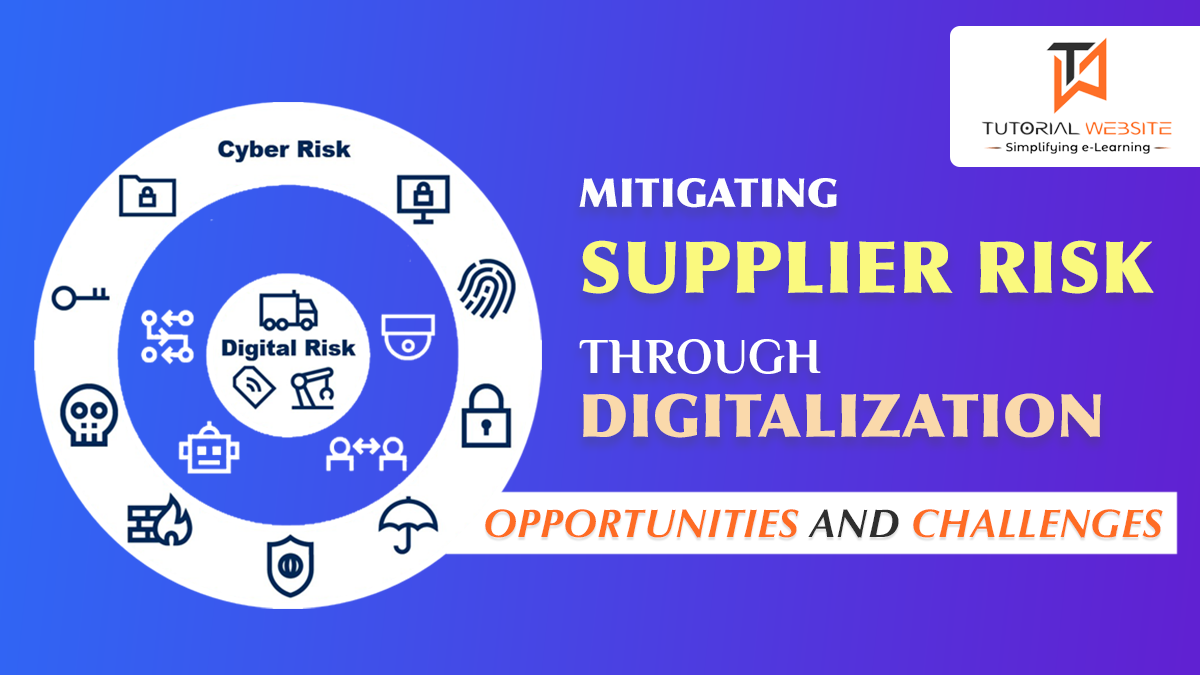The global supply chain is ever-evolving, and with the increasing demand for products and services, there is an urgent need to maintain a reliable and sustainable supply chain. One of the significant risks faced by businesses is supplier risks. This risk can result from disruptions such as natural disasters, financial instability, or political instability in supplier countries. The cost can be high, including delayed shipments, lost revenue, and reputational damage. Digitalization has emerged as a solution to mitigate supplier risk in recent years, and this article will discuss the opportunities and challenges of mitigating this through digitalization.
Opportunities of Digitalization for Risk Mitigation
Digitalization refers to integrating digital technologies into every aspect of a business. It offers many opportunities for businesses to mitigate supplier risk. Some of these opportunities include:
Improved Visibility: With the help of digitalization, businesses can better understand their suppliers’ operations. For example, by using digital tools such as supplier portals and analytics, businesses can gain insights into their suppliers’ financial stability, production processes, and delivery times.
Faster Response Time: Digitalization enables businesses to respond quickly to any disruptions in their supply chain. Using real-time monitoring and predictive analytics tools, businesses can detect potential disruptions early and take the necessary measures to prevent them from escalating.
Enhanced Collaboration: Digitalization enables businesses to collaborate more effectively with their suppliers. By using tools such as video conferencing, virtual whiteboards, and project management software, businesses can improve communication with their suppliers and enhance their ability to work together to solve problems.
Suggested Read: SAP Business One Supply Chain Management (SAP B1 SCM)
Challenges of Digitalization for Risk Mitigation
Despite the many benefits of digitalization for risk mitigation, there are also some challenges that businesses must overcome. Some of these challenges include:
Data Quality: Digitalization relies heavily on data, and data quality can significantly impact its effectiveness. Poor data quality can result in inaccurate insights and poor decision-making, increasing supplier disruptions risk.
Cost: Digitalization can be expensive, particularly for small and medium-sized businesses. Implementing digital tools and systems requires significant hardware, software, and training investment, which can be a barrier for some businesses.
Cybersecurity: Digitalization also increases the risk of cybersecurity threats. By integrating digital tools into their operations, businesses open themselves to potential cyberattacks, which can compromise their sensitive data and disrupt their operations.
Steps to Successfully Implement Digitalization
Mitigating risk through digitalization requires a comprehensive approach that considers each business’s unique needs and challenges. Here are some steps businesses can take to implement digitalization for supplier risk mitigation successfully:
1. Assess your current supply chain risks: The first step in mitigating supplier risk through digitalization is understanding your business’s risks. By conducting a comprehensive risk assessment, businesses can identify areas of weakness in their supply chain and develop a plan to address them.
2. Develop a digitalization strategy: Once you have identified the risks, the next step is to develop a digitalization strategy. This should include identifying the specific digital tools and systems needed to address the identified risks and a plan for implementing and integrating these tools into your operations.
3. Invest in data quality: As mentioned earlier, data quality is critical to the success of digitalization for supplier risk mitigation. Businesses should invest in data management tools and processes to ensure their decision-making data is accurate and reliable.
4. Train employees: Implementing digital tools and systems requires training employees on how to use them effectively. This includes training on data management, cybersecurity best practices, and how to use the specific digital tools being implemented.
Also Read: How Is Blockchain Affecting the Finance Sector?
Wrapping Words
Supplier risk is a significant concern for businesses, and digitalization offers many opportunities to mitigate this risk. By improving visibility, enhancing collaboration, and enabling faster response times, businesses can minimize the impact of supplier disruptions on their operations. However, businesses must also overcome challenges such as data quality, cost, and cybersecurity to realize digitalization’s benefits fully. Ultimately, the success of digitalization for risk mitigation depends on how well businesses can balance the opportunities and challenges associated with this transformation.

Vikas Maurya is a professional blogger and Data analyst who writes about a variety of topics related to his niche, including data analysis and digital marketing.






[…] Mitigating Supplier Risk through Digitalization: Opportunities and Challenges […]